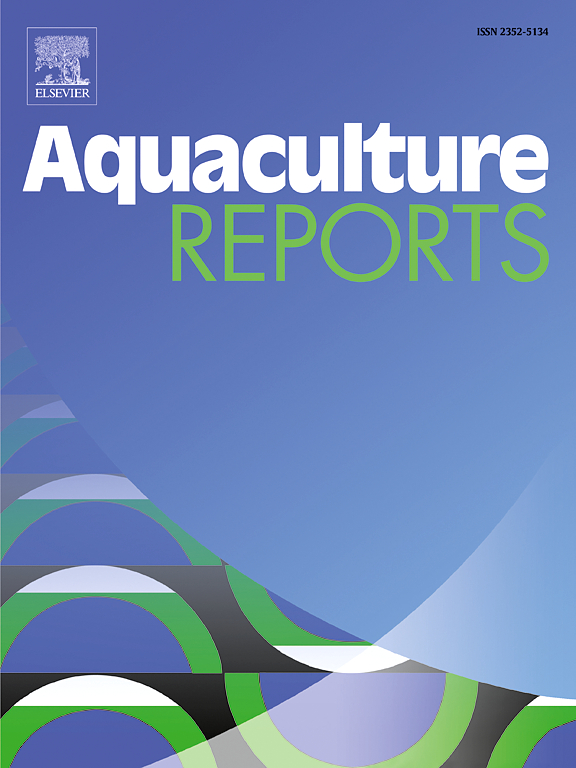Transcriptomic analysis of the toxic effects and potential mechanisms of fenvalerate on the liver of Odontobutis potamophila
IF 3.2
2区 农林科学
Q1 FISHERIES
引用次数: 0
Abstract
This study explored the toxic effects of short-term exposure (96 h) to fenvalerate (FEN) at environmental concentrations (C0.5: 0.5 µg/L) and application concentrations (C2: 2 µg/L) on the liver of Odontobutis potamophila and analyzed the potential toxicity mechanisms. The results showed that FEN exposure caused tissue damage and oxidative stress in O. potamophila liver in a concentration-dependent manner. Transcriptomic analysis revealed 2083 differentially expressed genes (DEGs) between control (CK) and C0.5 treatments and 2595 DEGs between CK and C2 treatments. Kyoto Encyclopedia of Genes and Genomes enrichment analysis revealed significant DEG enrichment in pathways such as serotonergic synapse, estrogen signaling, retrograde endocannabinoid signaling, etc. in C0.5, and in pathways such as oxidative phosphorylation, glutathione metabolism, retrograde endocannabinoid signaling, etc. in C2. Gene Ontology enrichment analysis showed significant DEGs enrichment in pathways such as DNA integration, obsolete oxidation-reduction process, regulation of DNA-templated transcription, etc. in C0.5, and in pathways such as obsolete oxidation-reduction process, translation, structural constituent of ribosome, etc. in C2. Investigation of genes related to liver mitochondrial function, including expression of cytochrome b (CYTB), cytochrome c oxidase subunit II (COX2), cytochrome c oxidase subunit III (COX3), and NADH dehydrogenase subunit 1 (ND1), demonstrated that CYTB and ND1 were significantly downregulated (P < 0.05) in a concentration-dependent manner, while COX2 and COX3 were significantly upregulated (P < 0.05) in C0.5 and C2, indicating that FEN could damage mitochondrial function in O. potamophila liver. In summary, this study revealed that the toxic effects of FEN on the liver of O. potamophila manifested as causing oxidative stress, resulting in tissue damage and mitochondrial dysfunction, and its key pathway of action is retrograde endocannabinoid signaling pathway. This results provide a theoretical basis for research on the toxic effects of FEN on aquatic organisms, and assessed the environmental risks of FEN exposure.
氰戊菊酯对嗜黄齿蟾肝脏的毒性作用及其潜在机制的转录组学分析
本研究探讨了环境浓度(C0.5: 0.5 µg/L)和施用浓度(C2: 2 µg/L)下短时间暴露(96 h)氰戊酸酯(FEN)对嗜黄齿蟾蜍(Odontobutis potamophila)肝脏的毒性作用,并分析了可能的毒性机制。结果表明,FEN暴露对嗜马铃薯螟肝脏组织损伤和氧化应激的影响呈浓度依赖性。转录组学分析显示,对照(CK)与C0.5处理之间存在2083个差异表达基因(deg), CK与C2处理之间存在2595个差异表达基因(deg)。京都基因与基因组百科富集分析显示,C0.5中5 -羟色胺能突触、雌激素信号通路、逆行内源性大麻素信号通路等和C2中氧化磷酸化、谷胱甘肽代谢、逆行内源性大麻素信号通路等均有显著的DEG富集。基因本体富集分析显示,在C0.5中DNA整合、废弃氧化还原过程、DNA模板转录调控等途径,以及在C2中废弃氧化还原过程、翻译、核糖体结构成分等途径中,DEGs富集显著。对肝脏线粒体功能相关基因,包括细胞色素b (CYTB)、细胞色素c氧化酶亚基II (COX2)、细胞色素c氧化酶亚基III (COX3)和NADH脱氢酶亚基1 (ND1)表达的研究表明,CYTB和ND1在C0.5和C2中呈浓度依赖性显著下调(P <; 0.05),而COX2和COX3在C0.5和C2中显著上调(P <; 0.05)。表明FEN可损伤嗜马铃薯螟肝脏线粒体功能。综上所述,本研究揭示了FEN对嗜茶大鼠肝脏的毒性作用表现为引起氧化应激,导致组织损伤和线粒体功能障碍,其关键作用途径是逆行内源性大麻素信号通路。本研究结果为研究FEN对水生生物的毒性作用以及评估FEN暴露的环境风险提供了理论依据。
本文章由计算机程序翻译,如有差异,请以英文原文为准。
求助全文
约1分钟内获得全文
求助全文
来源期刊

Aquaculture Reports
Agricultural and Biological Sciences-Animal Science and Zoology
CiteScore
5.90
自引率
8.10%
发文量
469
审稿时长
77 days
期刊介绍:
Aquaculture Reports will publish original research papers and reviews documenting outstanding science with a regional context and focus, answering the need for high quality information on novel species, systems and regions in emerging areas of aquaculture research and development, such as integrated multi-trophic aquaculture, urban aquaculture, ornamental, unfed aquaculture, offshore aquaculture and others. Papers having industry research as priority and encompassing product development research or current industry practice are encouraged.
 求助内容:
求助内容: 应助结果提醒方式:
应助结果提醒方式:


